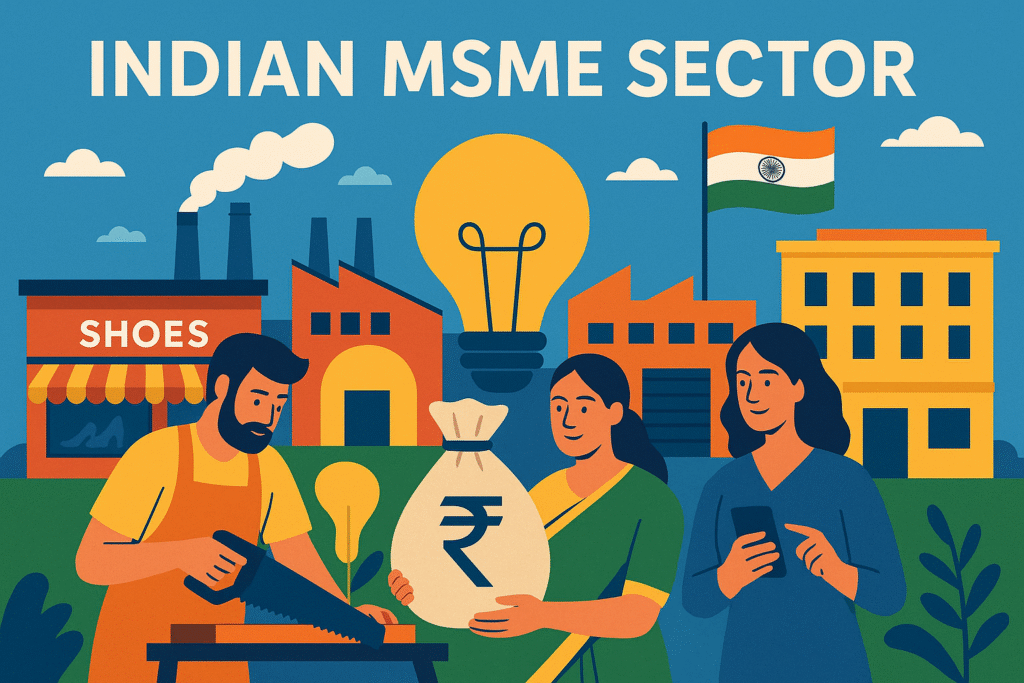India’s MSME Pulse: Powering the Nation, Yet Running on Grit
Step into the buzzing alleyways of Tiruppur or the rugged industrial pockets of Ludhiana, and you’ll witness the pulse of India’s economy—its Micro, Small, and Medium Enterprises (MSMEs). A charkha spun a revolution once; today, it’s the MSME loom that knits the nation’s economic fabric.
A Brief History: Roots in Self-Reliance
The MSME story in India is not new. Post-independence, India recognized early the importance of small-scale industries (SSIs), enshrining support in its Five-Year Plans. The Khadi and Village Industries Commission (KVIC) was one of the first institutional efforts, echoing Mahatma Gandhi’s vision of rural self-sufficiency.
By 2006, the MSMED (Micro, Small and Medium Enterprises Development) Act formalized this segment, shifting from the earlier SSI tag. The move acknowledged not just the economic but also the social role of MSMEs—as employment generators and as buffers against urban migration.
Today, India boasts over 63 million MSMEs, employing around 110 million people, and contributing nearly 30% to the GDP and 48% of exports. Their footprint spans everything from handicrafts to high-tech auto parts, from agarbattis to aerospace components.
The Global Mirror: How Does India Stack Up?
Compare India to the likes of Germany or China, and the contrast is instructive.
- Germany’s Mittelstand, often hailed as the gold standard, consists of family-owned businesses that focus on innovation and niche manufacturing. Backed by strong vocational training systems and financing frameworks, they are internationally competitive.
- China, meanwhile, turbocharged its MSME sector post-1990s with massive policy support, clustering models, and tech upgrades. SMEs contribute over 60% to its GDP, aided by low-interest loans and favorable export policies.
India’s MSMEs, though large in number, lag in productivity, technology adoption, and formalization. The informal nature of the sector—estimated at over 90%—limits access to credit, modern tools, and global markets.
Challenges on the Indian Turf
For Indian entrepreneurs, running an MSME often feels like pushing a boulder uphill—barefoot.
- Credit Crunch
Despite schemes like MUDRA and CGTMSE, a large chunk of MSMEs still rely on informal lenders. Complex paperwork, high collateral demands, and delayed loan approvals plague their financial lifeline. - Delayed Payments
Large buyers, including PSUs, often delay payments, disrupting cash flows. Despite the 45-day payment mandate under the MSMED Act, enforcement remains weak. - Regulatory Burden
While “ease of doing business” is improving, compliance with GST, labor laws, and environmental regulations remains cumbersome for small units. - Technological Backwardness
Many MSMEs still operate with decades-old machinery. Digital adoption, though rising post-COVID, remains patchy, especially in Tier II and III towns. - Skilling Gap
India’s demographic dividend doesn’t always translate into a skilled workforce. Training and upskilling remain limited, affecting quality and competitiveness.
Why They Still Shine: The Strengths of Indian MSMEs
Yet, amid constraints, Indian MSMEs exhibit remarkable resilience and unique strengths.
- Frugality and Adaptability
Indian entrepreneurs are masters of jugaad—improvising with limited resources to meet market demands. - Cultural Diversity = Product Diversity
From Pashmina shawls in Kashmir to leather goods in Kanpur, each MSME cluster reflects India’s rich regional identity. - Export Potential
Indian handicrafts, textiles, and engineering goods find strong demand globally. With better branding and packaging, MSMEs are breaking into niche global markets. - Rural Industrialization
MSMEs are not just urban-centric; they create livelihood opportunities in rural belts, thereby reducing pressure on cities.
Way Forward: From Survival to Strategy
The Indian government has launched a fleet of initiatives—Udyam Registration, ZED Certification, Samarth for digital transformation—but implementation and awareness remain spotty.
For real impact, reforms must go deeper:
- Facilitate faster credit disbursement through digital underwriting and cash flow-based lending.
- Strict enforcement of payment timelines by large buyers.
- Cluster-based support models with shared infrastructure, skilling centers, and market linkages.
- Tax incentives and subsidized tech upgrades for green and smart manufacturing.
Moreover, India’s MSMEs must look beyond survival and think scale, sustainability, and branding. The future lies in being not just suppliers to big companies, but independent brands and innovators.
MSME: A Sleeping Giant Ready to Sprint?
MSMEs in India are like the underdog in every good story—scrappy, spirited, and just one push away from greatness. With the right policy tailwinds and an entrepreneurial leap of faith, this sector could not just power India’s economy but also redefine its place in the global manufacturing and innovation map.
In a world that’s tilting toward localization and resilience, India’s MSMEs may well find their long-overdue moment in the sun.

